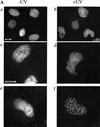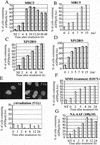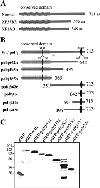Domain structure, localization, and function of DNA polymerase eta, defective in xeroderma pigmentosum variant cells
- PMID: 11157773
- PMCID: PMC312610
- DOI: 10.1101/gad.187501
Domain structure, localization, and function of DNA polymerase eta, defective in xeroderma pigmentosum variant cells
Abstract
DNA polymerase eta carries out translesion synthesis past UV photoproducts and is deficient in xeroderma pigmentosum (XP) variants. We report that poleta is mostly localized uniformly in the nucleus but is associated with replication foci during S phase. Following treatment of cells with UV irradiation or carcinogens, it accumulates at replication foci stalled at DNA damage. The C-terminal third of poleta is not required for polymerase activity. However, the C-terminal 70 aa are needed for nuclear localization and a further 50 aa for relocalization into foci. Poleta truncations lacking these domains fail to correct the defects in XP-variant cells. Furthermore, we have identified mutations in two XP variant patients that leave the polymerase motifs intact but cause loss of the localization domains.
Figures












Similar articles
-
Molecular analysis of mutations in DNA polymerase eta in xeroderma pigmentosum-variant patients.Proc Natl Acad Sci U S A. 2002 Jan 22;99(2):815-20. doi: 10.1073/pnas.022473899. Epub 2002 Jan 2. Proc Natl Acad Sci U S A. 2002. PMID: 11773631 Free PMC article.
-
Localization of DNA polymerases eta and iota to the replication machinery is tightly co-ordinated in human cells.EMBO J. 2002 Nov 15;21(22):6246-56. doi: 10.1093/emboj/cdf618. EMBO J. 2002. Corrected and republished in: EMBO J. 2003 Mar 3;22(5):1223-33. doi: 10.1093/emboj/cdf618. PMID: 12426396 Free PMC article. Corrected and republished.
-
Requirement for functional DNA polymerase eta in genome-wide repair of UV-induced DNA damage during S phase.DNA Repair (Amst). 2010 Jul 1;9(7):754-64. doi: 10.1016/j.dnarep.2010.03.013. Epub 2010 Apr 24. DNA Repair (Amst). 2010. PMID: 20457011
-
Xeroderma pigmentosum variant and error-prone DNA polymerases.Biochimie. 2003 Nov;85(11):1123-32. doi: 10.1016/j.biochi.2003.10.009. Biochimie. 2003. PMID: 14726018 Review.
-
Molecular mechanisms of UV-induced mutations as revealed by the study of DNA polymerase eta in human cells.Res Microbiol. 2002 Sep;153(7):441-5. doi: 10.1016/s0923-2508(02)01343-8. Res Microbiol. 2002. PMID: 12405351 Review.
Cited by
-
ZRANB3 is a structure-specific ATP-dependent endonuclease involved in replication stress response.Genes Dev. 2012 Jul 15;26(14):1558-72. doi: 10.1101/gad.193516.112. Epub 2012 Jul 3. Genes Dev. 2012. PMID: 22759634 Free PMC article.
-
Post-translational Regulation of DNA Polymerase η, a Connection to Damage-Induced Cohesion in Saccharomyces cerevisiae.Genetics. 2020 Dec;216(4):1009-1022. doi: 10.1534/genetics.120.303494. Epub 2020 Oct 8. Genetics. 2020. PMID: 33033113 Free PMC article.
-
NMR structure and dynamics of the C-terminal domain from human Rev1 and its complex with Rev1 interacting region of DNA polymerase η.Biochemistry. 2012 Jul 10;51(27):5506-20. doi: 10.1021/bi300566z. Epub 2012 Jun 28. Biochemistry. 2012. PMID: 22691049 Free PMC article.
-
High mobility of flap endonuclease 1 and DNA polymerase eta associated with replication foci in mammalian S-phase nucleus.Mol Biol Cell. 2005 May;16(5):2518-28. doi: 10.1091/mbc.e04-12-1066. Epub 2005 Mar 9. Mol Biol Cell. 2005. PMID: 15758026 Free PMC article.
-
Noncatalytic, N-terminal Domains of DNA Polymerase Lambda Affect Its Cellular Localization and DNA Damage Response.Chem Res Toxicol. 2017 May 15;30(5):1240-1249. doi: 10.1021/acs.chemrestox.7b00067. Epub 2017 Apr 13. Chem Res Toxicol. 2017. PMID: 28380295 Free PMC article.
References
-
- Arlett CF, Harcourt SA. Survey of radiosensitivity in a variety of human cell strains. Cancer Res. 1980;40:926–932. - PubMed
-
- Arlett CF, Harcourt SA, Broughton BC. The influence of caffeine on cell survival in excision-proficient and excision-deficient xeroderma pigmentosum and normal human cell strains following ultraviolet light irradiation. Mutation Res. 1975;33:341–346. - PubMed
-
- Bailly V, Lamb J, Sung P, Prakash S, Prakash L. Specific complex formation between yeast RAD6 and RAD18 proteins: A potential mechanism for targeting RAD6 ubiquitin-conjugating activity to DNA damage sites. Genes & Dev. 1994;8:811–820. - PubMed
-
- Berneburg M, Lehmann AR. Advances in Genetics. Vol. 43. San Diego, CA: Academic Press; 2001. Xeroderma pigmentosum and related disorders: Defects in DNA repair and transcription; pp. 71–102. - PubMed
Publication types
MeSH terms
Substances
LinkOut - more resources
Full Text Sources
Miscellaneous
